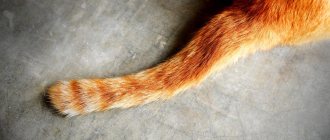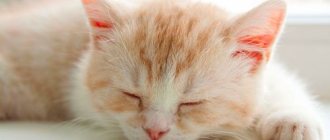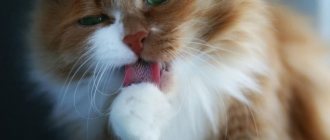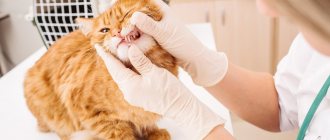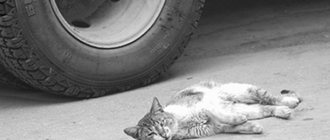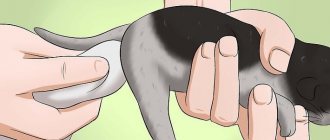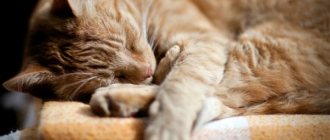What happens when you hit your head?
When an animal experiences a concussion, the functioning of the central nervous system and musculoskeletal system is disrupted for some time.
Most often, cats suffer from mild concussions. As you know, a strong concussion in a cat is the result of damage due to an impact. If proper treatment of a brain injury is not started in time, this is fraught with complications that can develop into chronic diseases that can worsen the pet’s health and limit its physical activity.
Every cat owner should be clearly aware that even a minor injury to the head can result in a concussion. Moreover, the more minor the damage, the more difficult it is to determine disorders in brain activity at home.
The cat may behave absolutely adequately, not suffer from a lack of appetite, and also not show signs of impaired motor functions. However, after some time, symptoms such as seizures, heart problems, and behavioral disorders may suddenly appear. This indicates a hidden brain injury.
Therefore, there is no need to wait for any symptoms of a concussion to appear after the impact - you need to take your pet to the veterinarian. Moreover, for emergencies there is a 24-hour veterinary clinic. It is better for this to be a false alarm than for the appearance of chronic diseases as a result of delayed treatment or lack of treatment at all.
Why does this happen?
The cause of a concussion in outdoor cats can be a fall from a height, being hit by a car on the road, an awkward jump from a tree, or being hit by a person.
Domestic cats receive head injuries as a result of heavy objects falling on them or hitting a wall if the animal is frightened or does not have time to brake in time. A concussion is accompanied by cerebrovascular accident and sometimes hemorrhage. This process results in disruption (temporary or permanent) of normal brain activity and activity.
First of all, you need to call a veterinarian. An experienced doctor will provide immediate assistance to the animal.
Strange animal behavior
You should promptly consult a specialist if your cat exhibits the following signs:
- Uneven pupils.
- Lack of pupillary response to light stimulus.
- Rapid and unnatural eye movements.
- A cloudy spot on the pupil, trembling of the iris, an abnormal appearance of the eye associated with displacement of the lens or damage to the ligaments that support it.
- Bruising on the head.
- Too pale or, conversely, too reddened mucous membranes.
- Dizziness (its sign is an unsteady and unsteady gait).
- Headache is a sign of it: the animal rests its head on a hard surface and stands motionless.
- Drowsiness.
- Attacks of aggression.
- Involuntary twitching of paws and facial muscles.
- Paralysis of limbs.
- Short-term loss of hearing or vision.
- Difficulty in orientation.
- Increased heart rate.
- Intermittent breathing accompanied by wheezing.
You need to know that the intensity of the symptoms of a concussion in a cat directly depends on the severity of the injury and the area affected. The mechanism of brain damage during trauma is as follows: the place where the blow was directly received suffers, and after that the brain hits the opposite wall of the skull, also receiving injury. During a concussion, the hypothalamus and brain stem are most vulnerable. Brain hemorrhage is very dangerous. This condition can lead to paralysis of the animal, temporary or permanent, so it is very important to get help as soon as possible. Typically, the main symptoms in animals disappear within 2 weeks. In any case, calling a veterinarian will not hurt.
Forecast
The prognosis depends on the severity of the disease, the area of traumatic brain injury and its degree. Coma that lasts more than 48 hours or a progressive deterioration of the condition is considered to have a poor prognosis.
Cats who have suffered a TBI should be regularly examined by a neurologist to monitor the dynamics and correct the prescribed therapy. Some patients recover quite slowly and the extent of their recovery cannot be predicted. Neurological signs can persist in cats for almost 6 months and it is important to be patient, follow all the recommendations of a veterinarian, provide a high-quality diet and good care.
Providing first aid for a concussion in a pet
If the cat received a blow to the head area and there is a suspicion that she has a concussion, then you need to bring her into a room with dim lights and put her down. If the symptoms do not disappear within ten minutes, then you should definitely seek advice from a specialist. Large cities usually have a 24-hour veterinary clinic.
In case of loss of consciousness, you must follow the following algorithm:
- do not try to stir up the animal or lay it on its side;
- in case of tongue retraction, ensure its straightening;
- Apply dry cold to the injury site;
- make a cold compress on the head (wet a towel in cold water, fold it several times and place it on the animal’s head);
- if there is an open wound, you need to stop the bleeding and apply a bandage;
- if vomiting begins, make sure that the cat does not choke on the mass;
- in case of cessation of breathing, it is recommended to perform indirect cardiac massage and artificial respiration.
Among the drugs that can be used without consulting a doctor, use an injection of caffeine and camphor. But it’s better not to treat a cat’s concussion on your own. The symptoms should prompt you to see a specialist.
How to provide first aid?
It is strictly forbidden to independently reduce or remove bone fragments in the event of an open injury.
In the room where the pet is, you need to close the curtains so that it is not disturbed by bright lighting.
If a cat hits its head, you need to act quickly, as the prognosis depends on it. Algorithm of actions:
- Ensure peace and quiet, turn off bright lights or draw curtains.
- Apply cold to the head for 15-20 minutes, this will reduce the risk of developing a hematoma and prevent brain swelling.
- Place a thin cloth band between your teeth to prevent your tongue from sticking.
- If vomiting begins, you need to make sure that the animal does not choke. Remove the remaining vomit from the mouth with a finger wrapped in a bandage.
- In case of cardiac arrest, perform artificial respiration: Lay the cat on its side and sharply compress the chest 6 times in the direction of the neck.
- Exhale into the cat's nose.
- Repeat pressing (at least 80 rubles per minute) and exhalation, alternating cardiac massage with artificial respiration - 15 sec./10 sec.
Concussion in a cat: causes and dangers
Felines are at greater risk of injury than other pets. This is due to the fact that they are not afraid of heights, love to explore new objects and are quite peaceful towards strangers. If for some reason your pet ends up on the street, there is a high probability that he will get hit by a car, fall from a tree, or get kicked by an unfriendly person. Often, pets fall out of a window, slide off a balcony railing, or a heavy object (a wooden shelf, a large flower pot, or other objects) falls on them. It is almost impossible to protect your ward from injury, since it is impossible to monitor him 24 hours a day.
What is a concussion?
A concussion in cats is a form of traumatic brain injury accompanied by disruption of brain activity. Failure of intracranial blood flow and compression of certain parts of the brain can provoke hemorrhage in the brain. Also, the disorder may be asymptomatic until a certain point.
Even a mild form of traumatic brain injury is very dangerous, as it can lead to serious consequences: paralysis, disruption of the central nervous system, tumor formation and other ailments.
Note! Even a minor head injury should not be ignored. Be sure to take your pet to a veterinarian for a full examination, even if no symptoms of a concussion are initially observed. After some time, he may develop seizures, heart problems and other diseases.
A severe concussion in a cat does not go away without symptoms, so it is imperative to know the main signs.
Symptoms of a concussion in a cat
Based on severity, concussions are classified as mild, moderate, and severe. Depending on this, the symptoms also change. The main signs of a concussion include:
- The presence of hematomas, bruises or bruises on certain parts of the body (head and neck).
- Temporary loss of consciousness (usually a few minutes), but the animal may remain unconscious for a long time if it is severely bruised.
- Impaired motor functions (shaky gait).
- Lack of appetite.
- Behavioral disorders: aggression towards the owner, attempts to find a secluded place and hide, fear, disorientation in space.
- Severe headache (the animal rests its head on hard surfaces and remains in this position).
- Drowsiness.
- Vomit.
- Complete or partial loss of hearing or vision.
- Intermittent breathing.
- Cardiopalmus.
- Convulsions of the limbs.
- Noticeable displacement of the lens capsule, trembling of the iris and other deformations of the visual organ.
Some signs are similar to other diseases, so veterinarians insist on urgent hospitalization at the first manifestation of the above symptoms.
The sooner your pet is examined by a veterinarian, the higher his chances of recovery.
It is almost impossible to protect your ward from injury, since it is impossible to monitor him 24 hours a day. Source: Flickr (Sherry_White)
Treatment
To relieve the animal from pain and possible risks associated with traumatic brain injury, the veterinarian prescribes complex therapy. A number of measures are taken to eliminate pain, prevent swelling and calm the nervous system: painkillers, sedatives and antipyretics are injected, and active cooling procedures are carried out. Sometimes surgical intervention is required when there is severe compression of skull fragments or the formation of hard hematomas. After surgery, prophylaxis with antibiotics is carried out. With a mild form of concussion, the animal is capable of self-healing. Key brain functions are restored through sleep and silence. For six months or more, the doctor must monitor the process of restoration of basic brain functions and, if necessary, adjust the treatment regimen.
A concussion in a cat is not an independent disease, but requires immediate treatment. Failure to promptly seek qualified medical help can lead to pathological changes in the body and even death of the patient. Do not be indifferent to your pets, provide them with timely assistance!
Video on the topic
Concussions in cats are caused by head contusions and are characterized by monocular abnormalities of the brain.
When a concussion occurs, the hypothalamus and brainstem are injured. With bruises, the cerebral hemispheres, cortex and subcortical white matter may be damaged. Brain destruction occurs not only at the site of injury, but also at the opposite wall of the skull. When a concussion occurs in cats, cerebral circulation is disrupted and the innervation of vital centers is disrupted.
Severe head injuries can lead to cerebral hemorrhage, destruction of the brain matter, etc.
What happens when you get a head injury?
Falls from heights and blows to the head lead to disruption of the central nervous system of the animal. A severe concussion in a cat is equivalent to a brain contusion. That is, in a limited area of the brain, organ tissue is damaged. Along with the immediate impact zone, the brainstem and hypothalamus are affected.
Strong impacts cause destruction of brain tissue both at the site of impact and at the opposite wall of the skull. A concussion disrupts the functioning of vital centers. Blood circulation may be impaired. In severe cases, a severe concussion in a cat is accompanied by hemorrhages in the brain tissue and necrosis.
Treatment of concussion in cats
After a head injury, the animal must be kept at rest. If necessary, stop the bleeding, perform cardiac massage and artificial respiration, and apply dry cold to the area of the bruise.
Caffeine, lobelia and camphor are administered to support the lungs and heart. To prevent cerebral edema and reduce the permeability of vascular walls, methenamine with caffeine or a 10% solution of calcium chloride is administered.
If such an unpleasant situation occurs and it is not immediately clear what and how to do to quickly resolve it, you should not only read the answers on this issue in this and other articles on this site, but also contact a veterinarian at your place of residence, since no one can help you. the power to make a diagnosis without seeing the animal.
A kitten has a traumatic brain injury, how to determine the severity, symptoms and signs
The degree of severity is determined only by a veterinarian after a full examination and in no case at home. If a kitten has a black eye, blood is flowing from the ears or nose, a hematoma has emerged and coordination of movements is impaired, then these are signs of a TBI.
Consequences of TBI in cats, cats and kittens
Pets do not always return to their previous appearance after an injury. Sometimes a TBI can lead to minor deviations that will not threaten health, but will interfere with living a full life.
Animals may have a squinted head or impaired movement. All this will depend on the severity of the injury and subsequent treatment of the pet.
How to treat traumatic brain injury in a kitten at home and what is done in a veterinary clinic
Such an injury cannot be treated at home! But in a hospital setting, a full medical history and external examination are first carried out, which makes it clear about the degree of complexity and further actions.
Then a neurologist works with the kitten, who will prescribe antibiotics and other drugs to restore the animal. Depending on the severity of the injury, the cat will be hospitalized and may be prescribed artificial ventilation.
Cats are very active and playful animals, but despite their agility, they can suffer serious injuries under certain circumstances, and concussions are no exception. How to recognize the symptoms of a concussion in cats and provide the necessary first aid should be understood in order to prevent severe consequences of the injury in the future.
Possible causes of head injury
The active lifestyle of cats allows for various types of injuries. The well-known beliefs that cats always land on their feet and have 9 lives do not always work. A cat can get a concussion for many reasons, including a fall from a height, a head injury from a falling heavy object, a blow to a hard surface, or even beating from a person.
Depending on the severity of the injury, circulatory disturbances, damage to the brainstem and hypothalamus, hemorrhage or tissue necrosis may occur in the brain, which in any case will affect the functioning of the central nervous system and the general condition of the pet. The most dangerous thing is that signs of a concussion in a cat may not appear immediately, but only after months or even years, when the process of pathological changes due to injury may no longer be reversible.
Treatment: which methods are effective?
To avoid severe consequences, the following treatment methods are used for traumatic brain injury in cats:
- Taking medications: To prevent edema, diuretics are prescribed - “Hypothiazide”, “Urotropin”, “Furosemide”, “Veroshpiron”.
- To maintain the functioning of the heart, injections should be made with drugs such as “Caffeine benzoate sodium 20%”, camphor solution 20%.
- Antishock medications - Prednisolone, Travmatin, Dexamethasone.
- Metoclopramide and Cerucal are effective in suppressing the gag reflex.
Return to contents
Symptoms of Concussion in Cats
Concussions in cats are not easy to recognize, especially if the owner did not witness a fall, blow, or other cause of injury to the pet. With a slight blow to the animal’s head, symptoms may not appear at all, but make themselves felt after some time in the form of chronic diseases and other pathologies in the pet’s body that appear against the background of the concussion. It should be remembered that the manifestations of concussion symptoms can be isolated, complex, or completely absent.
Symptoms of a concussion:
- Loss of consciousness;
- Restless animal behavior and aggression;
- Pallor or increased color of mucous membranes (eyes, mouth);
- Nystagmus (eye trembling);
- Unsteadiness of gait;
- Loss of spatial orientation;
- Lethargy and drowsiness;
- Lack of appetite;
- Nausea and vomiting;
- Tremor of the limbs or head;
- Convulsions;
- Paralysis;
- Rapid pulse;
- Heavy and uneven breathing;
- Headache (the animal rests its head against the wall).
Visible signs of a possible concussion:
- Wounds or abrasions on the animal’s head;
- Hematomas;
- Bruising;
- Change in color of the eye lens;
- Hemorrhages in the eyeball;
- Dislocated eye.
If the owner, due to the presence of at least a few symptoms or changes in behavior, suspects a concussion in his pet, then he should immediately show his pet to a veterinarian to confirm or refute the diagnosis.
First aid measures
The cat fell from a balcony or tree, was hit by a car or received a head injury in some other way - what to do? It happens that the owner witnesses an incident, but it is also possible that the owner only guesses about the concussion based on the characteristic symptoms. In order not to cause more harm to your pet, you should know what assistance measures need to be taken before the animal gets to the veterinarian.
After severe head trauma, animals often lose consciousness for several seconds or minutes. In this case, the first thing to do is to lay the pet on a flat surface on its side, straighten its tongue - to prevent it from sinking and ensure complete rest. Apply dry cold or a cold compress to the head. If there is vomit, clear it from the mouth and make sure that the cat does not choke on it. If there are wounds on the head or body, you should treat them with antiseptic agents (hydrogen peroxide, iodine, brilliant green) and apply a gauze bandage.
What not to do:
- Shake the animal;
- Give ammonia to sniff;
- Place the animal on its back;
- Exposure to bright lights or loud sounds.
Transporting a cat with a concussion to a veterinary clinic should also follow certain recommendations. Do not use a pet carrier or hold an animal in your arms. It is necessary to provide a flat and hard surface; a cardboard box with a wide bottom may be suitable for carrying. It should also be remembered that at first, the pet will be in a state of shock, and may not even be able to recognize the owner. This anxiety is temporary and gradually goes away.
Caring for a cat with a concussion
The resulting injury in the form of a concussion always affects not only the physical, but also the mental state. Regardless of the severity of the injury, the cat experiences stress and requires special care. After prescribing the necessary treatment, all responsibility and results for the pet’s recovery and its condition rest with the owner.
First of all, you should provide your pet with peace and quiet. It is necessary to protect the animal from loud sounds, animals, children and other factors that can disturb the mustachioed household member. For a speedy recovery, it is recommended to eliminate possible drafts and provide adequate nutrition. It is also important to ensure regular examinations by a veterinarian to fully monitor the healing process.
A concussion is a serious injury to a cat and requires immediate treatment. Symptoms may not fully manifest themselves, and it can be difficult to recognize them, but the sooner the veterinarian makes a diagnosis, the more favorable the treatment outcome will be. You should be attentive to changes in the behavior and general condition of your pet in order to timely recognize the disease. An attentive and caring owner is the key to a healthy and happy pet, regardless of whether it is a cat or a dog.
With all the endless love for a pet, the owner is not able to fully guarantee its safety. Accidents are a reality not only of human life, but also of cat life. Among the many injuries suffered by animals, head trauma is quite common.
What indicates a head injury in a cat?
If your cat hit its head when falling from a height, was in a car accident, or suffered at the hands of a cruel person, you should not wait for indirect signs of injury. A timely call to the veterinary clinic, calling a doctor at home, or independently transporting the animal to the hospital will ensure that the pet will not experience painful health problems in the future.
Clinical manifestations of brain contusion are:
- short-term or long-term loss of consciousness;
- disorientation in space, sometimes accompanied by unmotivated aggression;
- open bleeding wounds in the skull and collar area;
- hyperemia or pallor of the sclera, mucous membranes;
- ophthalmological disorders in the form of changes in the iris, lens, pupil, the appearance of spots on the sclera, visible hemorrhages;
- twitching of the eyeballs;
- tremor, loss of coordination, convulsions;
- partial numbness;
- abnormal pulse, breathing, salivation.
The presence of even one of the above signs should alert the owner and serve as a reason to contact a specialist.
Diagnostics
In cases where external injuries to the skull, bleeding from the ears or nose, neurological deficits, depression of consciousness, and loss of coordination are present, the diagnosis of traumatic brain injury is obvious. If the animal's history indicates that it is likely that it has suffered a traumatic brain injury, it is necessary to immediately take the animal to a veterinarian.
Depending on the condition of the animal, medical history and clinical signs, the following should be carried out:
- history taking and general physical examination (assessment of general condition)
- neurological examination - to assess the location of the injury and its severity;
- ophthalmological tests, first of all, examination of the fundus of the eye using an ophthalmoscope, which allows us to identify signs of high intracranial pressure and the condition of the vessels of the fundus;
- in some cases, it is advisable to perform X-ray scanning of the skull to exclude fractures and foreign objects (shots);
- special diagnostic methods (CT and MRI) can be used if there is a suspicion of intracranial damage (subdural hematomas, hemorrhages directly into the brain tissue, skull fractures, secondary cerebral edema).
Additionally, the general condition of the animal is assessed:
- Using a plain X-ray, it is possible to exclude other injuries (limb fractures, pneumothorax, hemothorax);
- Using ultrasound, the abdominal cavity of the animal is examined to exclude bruises and rupture of internal organs, intra-abdominal bleeding;
- a general blood test is performed;
- a biochemical blood test is performed;
- measure blood pressure.
Causes of injury
A cat can get a concussion for a variety of reasons. The most common of these is falling from a great height. Despite their agility and ability to always land on their paws, which significantly softens the blow, cats do not know how to circumvent the laws of physics. When falling from a considerable height, they do not die, like other animals, but receive a severe blow, causing a concussion of the brain and spinal cord.
Unfortunately, it is often the person who causes the injury. It can be inflicted accidentally (a blow from a door being opened, a kick while walking) or deliberately. Not all people love these cute animals.
A cat can get a concussion by hitting an obstacle at high speed. This happens when an animal gets scared of something and rushes headlong away. At this moment, there may be an obstacle in its path that the cat, in a panic, does not notice.
Finally, these animals create trouble for themselves. While playing or exploring the surrounding area, animals can throw a heavy object onto themselves, the impact of which can cause a concussion.
Causes of the disease
Statistics show that the most common causes of a concussion in a cat are:
- Collision with road vehicles: cars, motorcycles, scooters and even bicycles.
- Falling from a great height, unsuccessful landing when jumping from a tree to the ground. This is especially true for those pets who have the right to walk freely wherever they please. However, domestic cats are also at risk, as they often fall off balconies and window sills. Most often this happens in the summer, when apartment windows are wide open.
- Deliberate harm by hooligans. Unfortunately, in our time there are still enough people walking the streets of the city who find pleasure in inflicting pain on a weaker creature.
- Heavy objects falling on your pet's head. Such injuries are most dangerous for a small kitten, which simply will not have time to orient itself in the current situation and will not jump to the side. In addition, his skull is not yet strong enough, which means the consequences of the accident could be disastrous.
- In pursuit of prey, a furry predator is capable of reaching such a level of excitement that it may simply not notice a suddenly arising obstacle and slow down in front of it.
- Sometimes the owners themselves cause head injuries to a mustachioed friend by opening the door too sharply or accidentally stepping on the cat while it was sleeping.
Symptoms of Concussion in Cats
The most characteristic symptom for this injury is loss of consciousness immediately after the blow. The animal remains unconscious for several minutes, then comes to its senses. However, if there is a brain injury, the cat may fall into a coma. The severity of the concussion can be determined by the duration of unconsciousness. The longer the cat does not come to its senses, the more severe the injury and the more dangerous the consequences.
After the return of consciousness, the cat has poor spatial orientation for quite a long time. In some cases, memory loss may occur. The cat is afraid of the owner, does not recognize him, and can even show aggression.
You should contact your veterinarian immediately if your cat exhibits the following symptoms:
- The pupils have different sizes.
- The pupils react poorly or not at all to light.
- There are rapid, unpredictable movements of the pupils.
- A cloudy spot appeared on the pupil. The iris is shaking. This may indicate possible displacement of the lens due to ligament separation.
- Bruises were found on the head.
- The mucous membranes turned pale or, on the contrary, became excessively engorged with blood.
- The cat moves with an unsteady step.
- She has unmotivated attacks of aggression.
- Limbs twitch involuntarily.
- There is paralysis of the limbs.
- The cat is poorly oriented in the surrounding space.
- Breathing is intermittent, accompanied by wheezing.
It is important to understand that the intensity of symptoms depends on how severe the injury was to the animal. But this does not mean that if symptoms are mild, you do not need to take your cat to the veterinarian. It is necessary to consult a specialist in any case.
First aid for a cat with a concussion
In the case where the injury was caused by a strong blow to the head, you need to take the cat and bring it into a room with fresh air and dim lighting. If the animal is unconscious, then you need to do the following:
- Lay the cat on its side.
- Make sure your pet's tongue is not stuck.
- Apply a cold compress to the impact site. An ordinary towel soaked in water can play its role.
- If there is an open wound, then it must be covered with a bandage, after stopping the bleeding.
- When vomiting begins, you need to do everything to prevent the cat from choking.
- If the cat has stopped breathing, you will need to perform artificial respiration and massage the heart area.
Before the veterinarian arrives, it is possible to give the injured pet an injection of caffeine, but it is still better not to try to treat it yourself.
Do not forget that after a concussion the cat will be in a state of shock for several days. At this time, she may not recognize her owners and treats them aggressively. Therefore, you need to be patient.
If the cat still does not regain consciousness, and there is no way to call a veterinarian, then the pet should be transported for examination by a specialist on its side. However, the animal should not be placed in a carrier. It is better to transport the cat in your arms.
High-quality treatment of an animal is possible only after a comprehensive examination. Unfortunately, research methods such as X-rays and MRI cannot be applied to a cat. Or rather, it can be used, but for concussions in cats, these research methods will not be effective. Therefore, veterinarians have to make a diagnosis based on clinical data.
The specialist first assesses the severity of the concussion, and then, if necessary, gives injections to prevent brain swelling. In addition, the veterinarian may give injections of life-sustaining medications.
Drug treatment is limited to the use of analgesics and sedatives. Also, vascular medications will not be superfluous. For severe concussions, medications may be prescribed to support cardiac function.
The cat recovers from the concussion within a few weeks.
Animal treatment
Therapeutic measures are aimed primarily at reducing cerebral edema. For this purpose, drugs such as Hypothiazide, Indap, Indapamide are used.
For the same purpose, the veterinarian may prescribe diuretic drugs, for example Furosemide, Diacarb, Veroshpiron, and potassium supplements.
Some of these drugs also have a decongestant effect. Diakarb reduces intracranial pressure, relieves swelling of the brain, and has a mild sedative effect. The administration of methenamine with caffeine also reduces the permeability of the blood vessels of the damaged organ.
The animal is required to be prescribed painkillers: analgin, baralgin, no-spa. Cardiac medications are used to treat the disease: camphor, cardamine, caffeine.
Concussion in a cat - symptoms, diagnosis, prognosis
In the practice of veterinarians, there are a large number of different pathological processes that have serious complications that affect the further life of the animal.
One such serious condition is a concussion in a cat. A pathological process occurs against the background of mechanical injuries received by a domestic cat and is a milder form of traumatic brain injury with acute short-term impairment of brain function.
When the central nervous system, and in particular the cerebral cortex, is injured, processes of a pronounced degenerative nature begin to develop, appearing immediately after the injury or several months and even years later.
The task of the cat owner is to prevent injuries to the pet or, if a skull injury occurs, to carefully consider the state of health.
Thus, it is important to know the characteristic signs of disorders in the cerebral cortex that occur during a concussion and promptly provide the animal with the necessary assistance by showing it to a veterinary specialist.
What are the consequences?
One of the complications from injuries sustained in a pet may be partial paralysis.
Traumatic brain injury is a serious injury and, even if signs are identified promptly and treatment is started, the following complications may develop:
- Hemorrhagic stroke. It is characterized by rupture of a vessel and accumulation of blood in the space between the brain and the skull. May cause blurred vision, gait and memory impairment.
- Loss of vision. Occurs when the visual areas of the brain or nerve are injured.
- Brain swelling in a cat. The condition threatens the life of the animal, since the adult or kitten is subject to impaired oxygen exchange in the lungs and suffocation, which leads to death.
- Paralysis. Occurs when there is dysfunction of the areas of the brain responsible for the innervation of the limbs. May be partial or complete.
- Malignant neoplasms. Trauma can trigger a cell cycle failure, when cells begin to divide and grow abnormally quickly and form a tumor. The condition is dangerous due to the spread of metastases to vital organs, which leads to death.
Symptoms of concussion in cats, cats and kittens
Your furry pet can get a concussion in a variety of situations. The most common cases of concussion diagnosed in veterinary medicine are those caused by collisions between an animal and a vehicle.
An equally rare cause of serious pathology is a fall from great heights and an incorrect landing. This is especially true for cats that have free access to the street or balcony.
Cats that do not have their own home often become victims of so-called “hunters” who deliberately abuse the animals. By mocking a defenseless animal, hooligans hit the cat on the head, which leads to concussions, swelling and can even cause a coma.
The cat owner should monitor the pet's health very carefully, noting any changes.
A concussion in a cat as a result of an injury that occurred in front of the animal’s owner is characterized, first of all, by loss of consciousness. The cat loses consciousness, being in a characteristic fainting state for about several minutes.
In some cases, fainting lasts up to half an hour. The longer the period of fainting in an animal that suffered a head injury, the greater the changes in the brain.
The owner must monitor changes in the cat’s body and behavior after a mechanical head injury.
As a rule, the animal behaves strangely, has poor orientation in space, and ceases to recognize its owner. Sometimes a cat may begin to behave aggressively, hissing at the owner and biting him.
If the moment of receiving a head injury was missed by the owner, veterinary doctors strongly recommend paying attention to the following characteristic signs of a concussion:
- Fresh wounds, hematomas in the head area and abrasions. With severe mechanical damage to the head of a domestic cat, large hematomas are observed.
- Change in color of visible mucous membranes. In the area of the gums and conjunctiva of the eyes, severe pallor is possible, and hyperemia may also be noted.
- Pathological changes in the eyeball. When a cat suffers a concussion, the pupil becomes unnatural, losing its physiological size. By carefully observing a cat's eye during a concussion, the owner may notice trembling in the area of the iris, as well as various spots on the pupil. Severe brain damage provokes a lack of reaction of the pupil to a light stimulus, nystagmus (tremor of the eyeball itself), and temporary blindness.
- Changes in gait and disturbances in orientation in space. You can notice this condition with brain lesions, when the cat rests its head against the wall and tries to continue moving.
- Drowsiness, apathy, lethargy. When a concussion occurs, an animal may experience the opposite changes - aggression, growling and taking threatening poses.
- Changes in appetite, eruption of gastric contents.
- Convulsive contractions, convulsive phenomena in the muzzle and limbs (paralysis of the hind or front legs).
- Irregular breathing and heart rhythm. Shortness of breath and disturbances in the act of breathing.
Impaired blood flow in the brain can cause edema, increasing overall intracranial pressure. The most dangerous consequence of a concussion is rupture of blood vessels and hemorrhage.
Fractured paw in a cat
Rice. 1. Oblique fracture of the humerus in a cat.
If the pelvis is fractured (Fig. 2), the animal cannot stand on its hind legs, problems with defecation, severe pain, and it is difficult for the cat to stand on its hind legs. With an open fracture, the wound surface can be seen and bone may be exposed.
Fig.2. Pelvic fracture in a cat. Tearing of the iliosacral ligament.
Treatment rules and basic principles of cat care
Having suspected a pathological change in the functioning of the cerebral cortex in a cat, the veterinarian immediately begins a treatment regimen, selected individually taking into account the characteristics of the lesion.
First of all, the sick animal is provided with complete rest, placed in a quiet place, preferably pre-darkened without bright light or lamps.
It is recommended to place the cat on its side. If a cat received a head injury and lost consciousness in front of the owner, it is not advisable to revive the pet on your own, and in particular, do not shake it or allow it to breathe with ammonia. If a sick animal starts vomiting, it is necessary to carefully open the mouth and clean the oral cavity from the eruption of gastric contents.
The main task in treating a concussion in a cat is to relieve swelling or prevent its development.
For this purpose, medications such as thiazide diuretics are widely used in veterinary medicine:
- Hydrochlorothiazide;
- Hypothiazide;
- Dichlorothiazide;
- Arindap;
- Arifon;
- Lorvas;
- Pamid;
- Tenzar.
The administration of caffeine with methenamine has a positive therapeutic effect. This compound helps reduce increased vascular permeability in the brain. It is also important to prescribe analgesics - Baralgin, No-Shpa, Ibuprofen.
Maintaining the functioning of the cardiovascular system is achieved by administering camphor, cardamine or caffeine.
Increasing the functioning of the structural units of the brain is achieved by introducing nootropic drugs into the therapeutic treatment regimen, prescribed strictly by a veterinarian. These medications help improve the passage of nutrients into nerve cell structures, increasing metabolic processes in brain tissue.
When vomiting in a cat with a concussion, antiemetic medications are prescribed, and autonomic disorders are stopped by administering antispasmodics. It is important to use sedatives based on medicinal plants.
An important condition for a favorable outcome in case of a concussion is the correct creation of conditions for keeping a sick animal. The pet must be protected from various noises made by household appliances, animals or people. The sick animal should be completely at rest.
It is recommended at the time of therapy to place the cat in a room where it will have less contact with other household members or pets. Such an animal should not be released outside until it is completely cured.
After complete recovery, it is advisable to regularly take your pet to the veterinary clinic for diagnostic purposes. Preventive examinations by a doctor allow you to evaluate not only the process of brain cell restoration, but also the appropriate treatment prescribed in advance.
Author and presenter of the column: Veterinarian Igor Viktorovich Sanaev
Do you want to know more about the article or something? Call +79774692712, we will advise you.
Cost of treating a fracture in a cat
The cost of treatment for each individual fracture is considered based on the complexity of the fracture, its anatomical location, the cost of drugs for stabilization and anesthesia, metal structures (plates, wires, etc.) (Fig. 4, 5). On average, treatment of a simple fracture in a cat costs 6-10 thousand, the cost of a complex fracture or a fracture in a hard-to-reach place can reach 20-30 thousand.
Rice. 4. An example of osteosynthesis of a tibial fracture in a cat using a plate.
Fig.5. An example of osteosynthesis using Kirschner wires.
